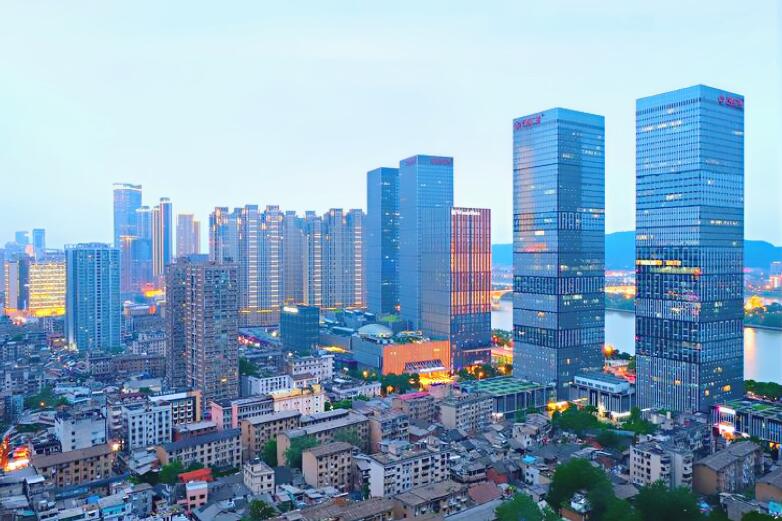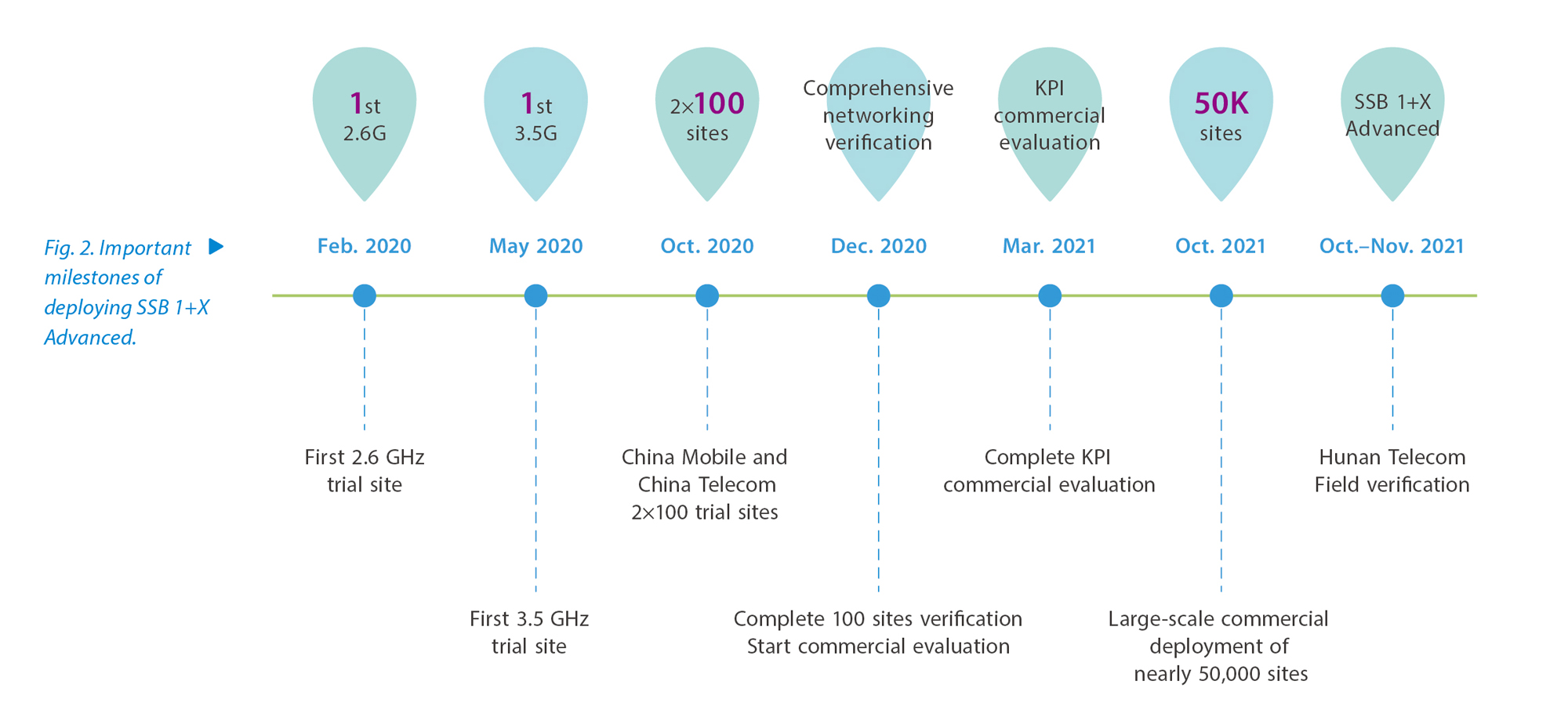As the urbanization process develops rapidly in China, major cities are planning to upgrade their core urban areas and CBDs. The high-rise building economy has brought strong impetus to the local economy. Guangzhou Tianhe CBD has more than 120 business buildings in an area of 12 square kilometers, with a GDP of over 300 billion yuan, where the densest skyscrapers above 300 meters in China are located. Changsha, a fast-growing city in central China, has planned and is building nearly 20 CBD regional centers (Fig. 1), of which more than 100 business buildings with more than 20 floors are gathered in the core CBD area of Wuyi Square alone. The occupancy rate of enterprises in these buildings is up to 90%, which belongs to a high-tax area.

Fig. 1. A CBD regional center in Changsha.
However, the sample data of office buildings in China shows that it is difficult to deliver high-quality wireless coverage services in high-rise buildings. Before 2022, the proportion of 5G indoor distributed coverage is less than 25%. The priority of 5G indoor distributed coverage is still very low during the current construction period, and the pain point of vertical three-dimensional coverage requirements is highlighted. The vertical coverage of high-rise buildings becomes a bottleneck, indoor signals are poor in deep coverage, and 5G traffic backflow to 4G is serious.
5G NR SSB broadcast channel evolves to support multi-beam configuration and management. Most operators pay more attention to horizontal coverage at the early stage of 5G. Therefore, multiple horizontal SSB beams (7 or 8 beams) are widely used. The multiple horizontal narrow SSB beams with more concentrated radiation energy ensure horizontal coverage and align with the coverage of beamforming service channels, but the vertical coverage in high-rise buildings is still extremely insufficient. Although SSB multi-layer multi-beam stacking solution can cover both horizontal and vertical coverage, there are over 10,000 options for the antenna weight database of SSB beams. Therefore, the algorithm efficiency is very low in selecting appropriate cell antenna weights. Operators do not want to see complex scenarios with too random and too many uncontrollable multi-layer multi-beam combinations. They are eager to reduce the complexity and cost of network planning and operations.
ZTE launched an innovative SSB 1+X solution for lean beam design in 2019. The solution supports wide/narrow beam combination, horizontal/vertical beam decoupling, and flexible beam layers adapting to complex and diverse coverage scenarios. Three major operators in China all adopted horizontal multi-beam networking for their 5G networks (China Mobile used 8 horizontal beams, and China Unicom and China Telecom employed 7 horizontal beams) in 2018–2019. Compared with the traditional single-beam networking, the 7/8-beam networking did provide enhanced cell edge coverage, and slight coverage improvement in driving test. Considering unstable performance and advantages of 5G horizontal multi-beam networking, there were many concerns and great pressure at that time to launch the SSB 1+X solution that combined horizontal and vertical coverage. For example, will there be serious interference between multiple horizontal beams and SSB 1+X adjacent networking? Can the coverage capability of "1" enhanced horizontal wide beam align with the horizontal multiple narrow beams? The planning and optimization tools for the SSB 1+X solution are not yet mature, how can the solution be promoted on a large scale? Should multiple horizontal beams be replaced by SSB 1+X as soon as possible or should they coexist for a long time?
The answer lies in the implementation of ZTE's SSB 1+X Advanced solution. Several important milestones have taken place in more than one year, such as the first SSB 1+X trials of Guangzhou@2.6GHz and Zhuzhou@3.5GHz, the comprehensive networking verification of 2×100 sites in Guangzhou and Changde, large-scale commercial evaluation based on real online user KPIs, and iterative innovation of SSB 1+X Advanced in Changsha, Hunan province (Fig. 2). The evolution of network value has undergone vertical coverage enhancement, three-dimensional coverage coordination, and both improvement of 5G offload ratio and user experience. The SSB 1+X Advanced solution has helped operators establish their 5G brands, build 3-Gigabit communities, and promote quality network growth. After field verification and many revisions in many cities, the solution is maturing and has been put into large-scale commercial use.

In large-scale commercial deployments, SSB 1+X provides enhanced 3D vertical coverage, resulting in a significant increase in 5G users/traffic/offload ratio. However, because operators pay close attention to 5G offload ratio, SSB 1+X cells will absorb edge users to the greatest extent both outdoors and indoors. Operators need to solve the problem of how to improve the 5G offload ratio while enhancing edge user experience. ZTE's 5G SSB 1+X Advanced solution can address the problem, in which AAPC intelligent optimization tool accelerates the pace of whole network to be self-intelligent and uses the 4G/5G switching strategy based on quality and the innovative algorithm for self-adaptive performance enhancement to continually improve 3D coverage, thus achieving the improvement of both 5G offload ratio and edge user experience. The 5G SSB 1+X Advanced solution was deployed in Changsha city from September to early November 2021. The number of 5G users increased by 15.67%, 5G traffic increased by 33.96%, 5G offload ratio increased by 3.86%, and 5G user average uplink throughput increased by over 20%. The deployment ratio of vertical X-beam cells in the CBD area of Wuyi Square in Changsha is up to 45%, making it one of the cities in China with a high proportion of X-beam cells deployed in the SSB 1+X solution.
The smooth evolution from horizontal multibeams to SSB 1+X had been implemented in nearly 100 cities in 30 provinces/municipalities by the end of October 2021. The total application of SSB 1+X is close to 50,000 sites, of which about about 10,000 sites (20%) have X vertical beams. SSB 1+X has good adaptability in four aspects such as NSA/SA structure, multiple application scenarios, multiple bands and anchors, and 64TR/32TR AAU hardware equipment.
ZTE will continue to work with operators to expand the replication and application of SSB 1+X Advanced. They will further explore AAPC intelligent optimization tools and intelligent orchestration to improve network value and user experience, accelerate the evolution to self-intelligence networks, and maintain technology leadership, network leadership and market leadership.